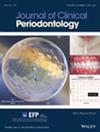Persisting Chronic Periodontal Disease as a Risk Factor for Cardiovascular Disease: A Nationwide Population-Based Cohort Study
Abstract
Aims
Epidemiological studies have consistently established a positive association between periodontal disease (PD) and cardiovascular disease (CVD). However, large-scale investigations exploring the impact of changes in PD status on CVD risk are scarce. This study aimed to investigate the association between the dynamics in PD and the risk of incident CVD in a nationally representative population.
Methods
Utilising data from the Korean National Health Insurance Service, a cohort of 1,242,570 participants who underwent oral health exams in 2003 and a follow-up exam in 2005–2006 was analysed. Participants were categorized into groups based on changes in PD status: absent, improvement, onset and persistent. Cox proportional hazard models were employed to assess the multivariate-adjusted hazard ratios (HRs) for composite CVD outcomes, including death, myocardial infarction and stroke.
Results
Over a mean follow-up of 14.4 years, 79,810 (6.4%) cases of composite CVD occurred, including 14,296 (1.2%) myocardial infarctions, 3247 (0.3%) hemorrhagic strokes and 8900 (0.7%) ischemic strokes. Individuals with persistent PD showed the highest risk of CVD (HR: 1.04, 95% CI: 1.03–1.06, p < 0.001). In the pairwise comparisons, the PD improvement group exhibited a lower composite CVD risk than the PD persistent group (HR: 0.97, 95% CI: 0.96–0.99, p = 0.010); similarly, the PD onset group showed a lower risk than the PD persistent group (HR: 0.94, 95% CI: 0.93–0.96, p < 0.001). This pattern was consistent in the risk of death, with both the PD improvement and PD onset groups showing a lower risk of death than the PD persistent group.
Conclusion
This study suggests the dynamic nature of PD as a potential modifiable risk factor for CVD. Individuals with chronically persistent PD showed an elevated incidence risk of CVD, emphasizing the importance of managing PD in preventive strategies.

 求助内容:
求助内容: 应助结果提醒方式:
应助结果提醒方式:


